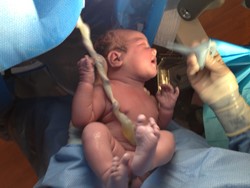Waiting just 1-2 minutes after birth before cutting your baby’s umbilical cord can protect her from anemia, yet most obstetricians don’t do it. I know why—I’m a hospital based pediatrician and I attend deliveries regularly. Practicing “delayed cord clamping,” as this procedure is called, means that the OB has to hold the crying, wet, squirming baby down at the level of the mother’s vagina for 1-2 minutes, letting gravity pull the blood from the placenta into the baby’s tiny body. It can seem like an eternity. At that serene moment when the baby is finally out, all the mom wants is to see and hold her baby, and all the OB wants is to give her the baby. Traditionally, the OB clamps the cord, puts the baby on the mom’s abdomen, and everyone is happy—deliriously happy, actually. But delayed cord clamping seems to spoil the moment and make the delivery awkward.
 A new research study published in the medical journal Lancet says it doesn’t have to be this way. Babies who were placed on their mother’s abdomen or chest for 2 minutes before cord clamping got just as much blood from their placenta as babies who were held at the level of the vagina. It seems that the primary force pushing blood from the cord into the baby is the contracting uterus, not gravity.
A new research study published in the medical journal Lancet says it doesn’t have to be this way. Babies who were placed on their mother’s abdomen or chest for 2 minutes before cord clamping got just as much blood from their placenta as babies who were held at the level of the vagina. It seems that the primary force pushing blood from the cord into the baby is the contracting uterus, not gravity.
So give that new baby to mom.
Ironic, isn’t it, how we ignored the wisdom of antiquity here. This is how deliveries have been done for most of history—put the baby on mom’s abdomen and cut the cord 1-2 minutes after birth. But now we have the research that shows it’s the right way.
In this study, 194 healthy, full-term babies were placed on their mother’s abdomen or chest after delivery and 197 babies were held at the level of the vagina. After two minutes the umbilical cord was clamped. The babies were all weighed before and after the two minute interval. The babies placed on their mother’s chest or abdomen gained, on average, 53 grams of blood from their placenta. The babies held at the level of the vagina gained an average of 56 grams. The small difference in the two groups is not statistically significant.
But most of the babies I see delivered get essentially no extra blood from their placenta. The cord is clamped less than a minute after delivery. I hope this research will change things.
Delayed cord clamping is an easy procedure with big benefits and very limited risks. I’ve written previously about infant anemia and it’s consequences, including impaired cognitive development. The risks of delayed cord clamping are few—it may increase an infant’s risk of jaundice by about 2%. But even severe cases of jaundice can be easily treated with phototherapy. Anemia, on the other hand, requires months or years of iron supplementation.
With cesarean section deliveries, it is not clear if there is a benefit to delayed cord clamping. In a c-section, the uterus has been cut and it does not contract the same way as a uterus after a vaginal delivery. Less blood gets pushed to the baby before the cord is clamped. And waiting around to cut the cord after c-section may put the mother at risk of hemorrhage or excessive bleeding.
Are you planning to bank your baby’s cord blood? Or donate it to a cord bank? You can still have delayed cord clamping. Cord blood collection for banking for donation is performed after the cord is cut. Even after delayed cord clamping there will be plenty of cord blood left for banking or donation. I have five children, and with the first four I donated their cord blood to a public bank. With the fifth, I changed my mind and privately banked her blood. Here’s why.
Delayed cord clamping is just one more example of how the medical establishment is changing birthing procedures to be more mom and family centered. In the past few years we’ve changed the way a baby spends her first few minutes of life—for the better. Now, healthy babies spend more time bonding with their family. Medical evaluations, tests and baths can usually wait.
Talk to your obstetrician about delayed cord clamping, and be sure to include this request in your birth plan. Don’t have a birth plan? You need one. It will only take a few minutes to write. Here are 10 essential tips for writing a birth plan.





I’ll have to forward your post to my sister, who published a randomized controlled trial done in Mexico (http://www.ncbi.nlm.nih.gov/pubmed/16782490) that showed that infants that underwent delayed cord clamping had significantly reduced incidence of iron deficiency out to 6 months of age!
Now if only ACOG took notice of these studies! Sometimes I think they’re competing for the fastest clamp/cut time, even if perfectly healthy, term babies.